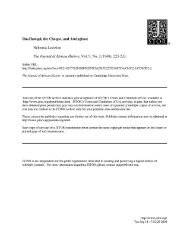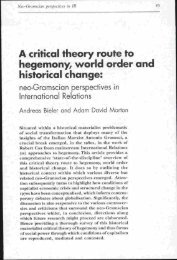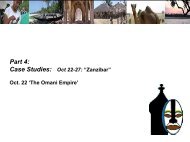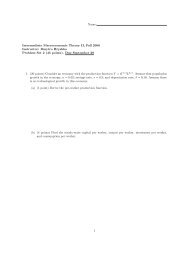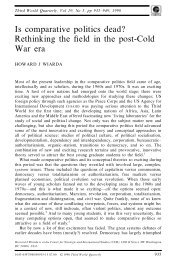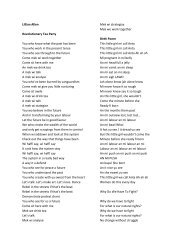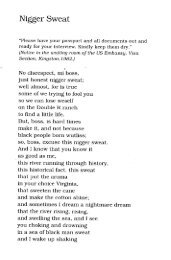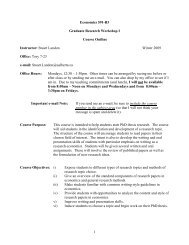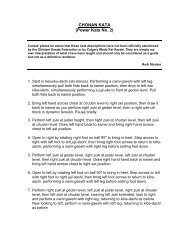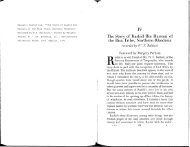personal memories revolutionary states and indian ocean migrations
personal memories revolutionary states and indian ocean migrations
personal memories revolutionary states and indian ocean migrations
Create successful ePaper yourself
Turn your PDF publications into a flip-book with our unique Google optimized e-Paper software.
His publications (described in an essay<br />
by Christoph Neumann) were all in<br />
Ottoman, but his tract justifying the<br />
importance of printing is significant: it<br />
would bring accurate texts to more<br />
people at prices they could manage to<br />
pay. Surely such an enlargement of<br />
general knowledge was an advantage to<br />
the reforming sultan.<br />
The major centers in the<br />
nineteenth century were Cairo, Beirut,<br />
<strong>and</strong> for a time Istanbul. In Egypt the<br />
initiative came from the state: from<br />
authorities of the Napoleonic<br />
expedition, whose press issued military<br />
announcements <strong>and</strong> proclamations in<br />
Arabic to a generally hostile population<br />
in 1798-1801, <strong>and</strong> then in 1819/20,<br />
from the ruler Muhammad Ali, for<br />
whom the presses he established in<br />
Bulaq, still a suburb of Cairo, were a<br />
tool for his reforming projects. By the<br />
end of the century, the Matba`a at Bulaq<br />
had produced a remarkable number of<br />
titles, most of them by typography using<br />
fonts copied from those of the Ottoman<br />
Imperial Press in Istanbul. Lithography<br />
was preferred for religious works, as<br />
with the 1924 Azhar Quran, but most of<br />
the Bulaq publications had another<br />
focus: school books, the first newspaper<br />
in the Arabic world (1828, initially<br />
published in Arabic <strong>and</strong> Turkish both),<br />
<strong>and</strong> Arabic classics. A Thous<strong>and</strong> <strong>and</strong><br />
one Nights (Alf layla wa-layla) appeared<br />
in 1835, the volumes of Ibn Khaldun’s<br />
great history Kitab al-`ibar in 1867.<br />
The initiative in Beirut came<br />
rather from non-governmental sources:<br />
the American missionary presses using a<br />
type face that came to be called<br />
"American Arabic," <strong>and</strong> printing houses<br />
founded by Arab Christians with a wide<br />
inventory – non-governmental<br />
newspapers <strong>and</strong> periodicals, Arabic<br />
literature, encyclopedias, science<br />
textbooks. The first press sponsored by<br />
a Muslim began in 1874, <strong>and</strong><br />
immediately began to publish a<br />
newspaper. Interestingly enough, all<br />
these presses used American Arabic<br />
type. Istanbul is yet a third example, for<br />
86<br />
its publishing achievement in the<br />
nineteenth century was shaped by the<br />
vision of a remarkable Arab intellectual,<br />
the Lebanese writer Ahmad Faris al-<br />
Shidyaq. After editing for a missionary<br />
press in Malta <strong>and</strong> traveling to Engl<strong>and</strong><br />
(where he published his translation of<br />
the Bible in Arabic) <strong>and</strong> Tunis (where he<br />
converted to Islam), al-Shidyaq was<br />
invited by the Sultan to Istanbul in 1859<br />
to become the major figure in Arabic<br />
editions at the imperial press. He<br />
immediately founded the newspaper al-<br />
Jawa’ib, which became one of the most<br />
widely circulated periodicals in the Arab<br />
world. In 1870 he established his own<br />
press, publishing there his newspaper,<br />
his own writings <strong>and</strong> those of other<br />
contemporary intellectuals, <strong>and</strong><br />
beautifully edited editions of classical<br />
Arabic literature. After his death in<br />
1887, Roper notes, publishing in Turkey<br />
concentrated increasingly on the<br />
Turkish language, but al-Shidyaq’s<br />
efforts helped widen the Arabic reading<br />
public.<br />
This summary of the Arabic<br />
material in Middle Eastern Languages <strong>and</strong><br />
the Print Revolution gives only a partial<br />
look at the treasures in the volume.<br />
Ulrich Marzolph’s chapter on<br />
nineteenth-century Iran brings with it an<br />
important discussion of lithography,<br />
used there well beyond religious<br />
literature, <strong>and</strong> impressive book<br />
illustration, including an 1847 picture of<br />
the lithographic process – from the<br />
preparation of the etching acid to the<br />
working of the press by the bare feet of<br />
a pressman. Moreover, the multiple<br />
languages <strong>and</strong> locations considered add<br />
complexity <strong>and</strong> a dialogic character to<br />
the account: in late nineteenth-century<br />
Jerusalem, presses were producing<br />
books in Hebrew, Arabic, Armenian,<br />
Greek, <strong>and</strong> Turkish.<br />
In certain ways the book<br />
undermines the stereotyped narrative of<br />
"first the progressive West, then the<br />
backward rest." Since Arabic block<br />
prints predate those in Europe by<br />
several centuries <strong>and</strong> printing with<br />
Vol. 5, Fall 2005, © 2005 The MIT Electronic Journal of Middle East Studies



